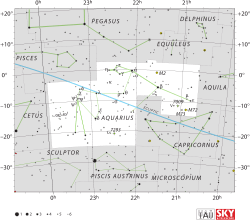Psi3 Aquarii
For other stars named Psi Aqr, see Psi Aquarii

| |
| Observation data Epoch J2000 Equinox J2000 | |
|---|---|
| Constellation | Aquarius |
| Right ascension | 23h 18m 57.67658s[1] |
| Declination | –09° 36′ 38.7054″[1] |
| Apparent magnitude (V) | 4.98[2] |
| Characteristics | |
| Spectral type | A0 V[3] |
| U−B color index | –0.02 |
| B−V color index | –0.02[2] |
| Astrometry | |
| Radial velocity (Rv) | –10[4] km/s |
| Proper motion (μ) | RA: +43.33[1] mas/yr Dec.: –8.30[1] mas/yr |
| Parallax (π) | 12.47 ± 0.43[1] mas |
| Distance | 262 ± 9 ly (80 ± 3 pc) |
| Details | |
| Radius | 2[5] R☉ |
| Rotational velocity (v sin i) | 144[6] km/s |
| Other designations | |
| Data sources: | |
| Hipparcos Catalogue, CCDM (2002), Bright Star Catalogue (5th rev. ed.) | |
Psi3 Aquarii is the Bayer designation for a visual binary star[8] system in the constellation of Aquarius. It has an apparent visual magnitude of 4.98,[2] which is bright enough to be seen with the naked eye. Parallax measurements give a distance estimate of roughly 262 light-years (80 parsecs).[1]
The main component of this system is an A-type main sequence star with a stellar classification of A0 V.[3] Its companion is an 11th magnitude star 1.5 arcseconds from the primary.[9] This system is an X-ray source with a luminosity of 8.34 × 1029 erg s−1. This radiation most likely comes from the companion star.[8]
References
- 1 2 3 4 5 6 van Leeuwen, F. (November 2007), "Validation of the new Hipparcos reduction", Astronomy and Astrophysics, 474 (2): 653–664, arXiv:0708.1752
 , Bibcode:2007A&A...474..653V, doi:10.1051/0004-6361:20078357.
, Bibcode:2007A&A...474..653V, doi:10.1051/0004-6361:20078357. - 1 2 3 Johnson, H. L.; et al. (1966), "UBVRIJKL photometry of the bright stars", Communications of the Lunar and Planetary Laboratory, 4 (99), Bibcode:1966CoLPL...4...99J.
- 1 2 Cowley, A.; et al. (April 1969), "A study of the bright A stars. I. A catalogue of spectral classifications", Astronomical Journal, 74: 375–406, Bibcode:1969AJ.....74..375C, doi:10.1086/110819.
- ↑ Wilson, Ralph Elmer (1953), General Catalogue of Stellar Radial Velocities, Washington: Carnegie Institution of Washington, Bibcode:1953GCRV..C......0W.
- ↑ Pasinetti Fracassini, L. E.; et al. (February 2001), "Catalogue of Apparent Diameters and Absolute Radii of Stars (CADARS) - Third edition - Comments and statistics", Astronomy and Astrophysics, 367: 521–524, arXiv:astro-ph/0012289
 , Bibcode:2001A&A...367..521P, doi:10.1051/0004-6361:20000451.
, Bibcode:2001A&A...367..521P, doi:10.1051/0004-6361:20000451. - ↑ Royer, F.; Zorec, J.; Gómez, A. E. (February 2007), "Rotational velocities of A-type stars. III. Velocity distributions", Astronomy and Astrophysics, 463 (2): 671–682, arXiv:astro-ph/0610785
 , Bibcode:2007A&A...463..671R, doi:10.1051/0004-6361:20065224.
, Bibcode:2007A&A...463..671R, doi:10.1051/0004-6361:20065224. - ↑ "95 Aqr -- Star", SIMBAD Astronomical Object Database, Centre de Données astronomiques de Strasbourg, retrieved 2012-07-05.
- 1 2 Schröder, C.; Schmitt, J. H. M. M. (November 2007), "X-ray emission from A-type stars", Astronomy and Astrophysics, 475 (2): 677–684, Bibcode:2007A&A...475..677S, doi:10.1051/0004-6361:20077429.
- ↑ Eggleton, P. P.; Tokovinin, A. A. (September 2008), "A catalogue of multiplicity among bright stellar systems", Monthly Notices of the Royal Astronomical Society, 389 (2): 869–879, arXiv:0806.2878
 , Bibcode:2008MNRAS.389..869E, doi:10.1111/j.1365-2966.2008.13596.x.
, Bibcode:2008MNRAS.389..869E, doi:10.1111/j.1365-2966.2008.13596.x.
External links
This article is issued from Wikipedia - version of the 6/6/2016. The text is available under the Creative Commons Attribution/Share Alike but additional terms may apply for the media files.